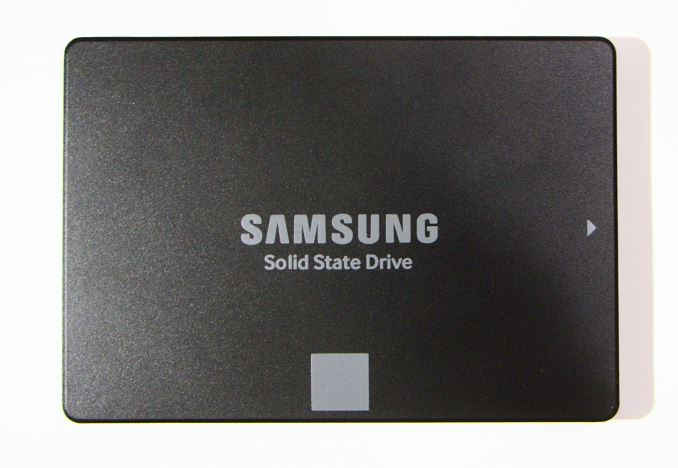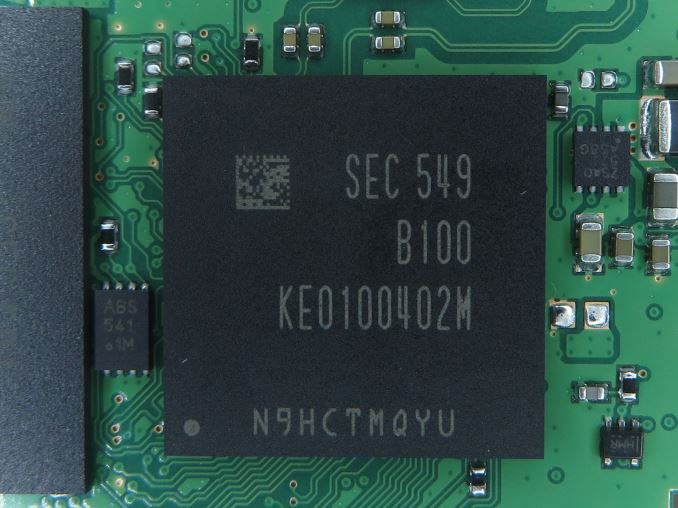The Samsung 750 EVO (120GB & 250GB) SSD Review: A Return To Planar NAND
by Billy Tallis on April 22, 2016 8:00 AM EST
Since the introduction of their first consumer TLC SSD with the SSD 840, Samsung's consumer/retail SATA SSD lineup has consisted of two product families: the MLC-based Pro drives, and the TLC-based 840 and EVO drives. The strength of Samsung's SSD controllers and the advantages of 3D NAND have allowed the 850 EVO to maintain a solidly mid-range position in the SSD market well above any other drive using TLC NAND.
Meanwhile, with the strength of the 850 EVO as a near-midrange product - and with pricing to match - like so many other vendors over the last year, Samsung has also been developing a true low cost TLC drive for the mass market. The end result is the Samsung 750 EVO, which we're revieiwng today. The 750 EVO establishes a new budget-oriented product line that competes in the cutthroat low end of the market where price per GB is the most important aspect of the product.
There are several design choices that help minimize the cost of the 750 EVO, aside from the obvious choice of TLC over MLC. The MGX controller it borrows from the lower capacity 850 EVOs is a dual-core version of Samsung's usual triple-core architecture. Similarly, the 750 EVO is only available in 120GB and 250GB sizes, so there is no high-priced high capacity model. Consequently, with only two small capacities, the 750 EVO line is served by a single tiny PCB layout, made even smaller by the fact that Samsung has put the 256MB of DRAM in the same package as the SSD controller.

Samsung MGX controller with onboard 256MB DRAM
But the most significant aspect of the 750 EVO is that it doesn't use the 3D NAND that has been a key competitive advantage for Samsung's 850 product lines. Samsung has continued development of planar NAND even after transitioning their retail SSDs to 3D NAND, and the 750 EVO in turn uses 16nm planar TLC. It doesn't offer the same performance or endurance of Samsung's 3D NAND, but it does significantly lower the cost of the drive.

128GB of 16nm TLC NAND in a single package
The 16nm TLC NAND is the successor to Samsung's 19nm TLC that had a troubled tenure in the 840 EVO. With the 840 EVO, data at rest on the drive degraded over time and eventually required the use of more thorough and thus slower error correction when read back. As a result the 750 EVO inherits the benefits of all the firmware work Samsung did to mitigate the read speed degradation. This, for what it's worth, gives Samsung some degree of a leg-up against other 16/15nm TLC drives that face the same challenges.
| Samsung TLC SATA SSD Comparison | |||||
| Drive | 750 EVO 120GB | 750 EVO 250GB | 850 EVO 120GB | 850 EVO 250GB | |
| Controller | MGX | MGX | |||
| NAND | Samsung 128Gb 16nm TLC | Samsung 32-layer 128Gbit TLC V-NAND | |||
| DRAM | 256MB | 256MB | 256MB | 512MB | |
| Sequential Read | 540MB/s | 540MB/s | 540MB/s | 540MB/s | |
| Sequential Write | 520MB/s | 520MB/s | 520MB/s | 520MB/s | |
| 4KB Random Read | 94K IOPS | 97K IOPS | 94K IOPS | 97K IOPS | |
| 4KB Random Write | 88K IOPS | 88K IOPS | 88K IOPS | 88K IOPS | |
| 4KB Random Read QD1 | 10K IOPS | 10K IOPS | 10K IOPS | 10K IOPS | |
| 4KB Random Write QD1 | 35K IOPS | 35K IOPS | 40K IOPS | 40K IOPS | |
| DevSleep Power | 6mW | 2mW | |||
| Slumber Power | 50mW | 50mW | |||
| Active Power (Read/Write) | 2.1W / 2.4W (Average) | 2.4W / 2.8W (Average) | Max 3.7W / 4.4W | ||
| Encryption | AES-256, TCG Opal 2.0, IEEE-1667 (eDrive) | AES-256, TCG Opal 2.0, IEEE-1667 (eDrive) | |||
| Endurance | 35TB | 70TB | 75TB | ||
| Warranty | Three years | Five years | |||
By and large the performance specifications for the 750 EVO match the lower capacity 850 EVO, though a slightly lower random write speed at a queue depth of one hints that the 750 EVO may require a bit more background wear leveling work. The feature set is identical to the 850 EVO, making the 750 EVO one of the few low-end drives to support TCG Opal encryption.
Samsung's marketing strategy for the 750 EVO is a little different from their previous retail SSD products. The 750 EVO is targeted specifically at system integrators and system builders, rather than at users looking to upgrade an existing machine. Consequently, they aren't pushing to make the 750 EVO available from as wide a range of retail outlets. Enough of the major online retailers have it in stock that it is not difficult to obtain.
This review will focus on comparing the 750 EVO against Samsung's other SATA SSDs and against other current-generation low-end TLC SSDs of comparable capacity. Our Bench tool can assist in making other comparisons.
| AnandTech 2015 SSD Test System | |
| CPU | Intel Core i7-4770K running at 3.5GHz (Turbo & EIST enabled, C-states disabled) |
| Motherboard | ASUS Z97 Pro (BIOS 2701) |
| Chipset | Intel Z97 |
| Memory | Corsair Vengeance DDR3-1866 2x8GB (9-10-9-27 2T) |
| Graphics | Intel HD Graphics 4600 |
| Desktop Resolution | 1920 x 1200 |
| OS | Windows 8.1 x64 |
- Thanks to Intel for the Core i7-4770K CPU
- Thanks to ASUS for the Z97 Deluxe motherboard
- Thanks to Corsair for the Vengeance 16GB DDR3-1866 DRAM kit, RM750 power supply, Carbide 200R case, and Hydro H60 CPU cooler










109 Comments
View All Comments
BurntMyBacon - Monday, April 25, 2016 - link
@vladx: "Don't know what you mean, I also have a 840 EVO and can confirm the performances issues are gone after the 2nd fix."The fix forces a periodic rewrite of data that shouldn't have been necessary. Also, the fix doesn't work for machines that are powered down for large periods at a time as it requires power to monitor and execute the rewrites. This fix isn't optimal as it lowers the effective endurance of the drive. Combine that with the fact that the drive uses TLC flash with a write endurance of 1000x and you have a situation that enthusiasts aren't exactly "enthusiastic" to hear about.
That said, under normal consumer use, it will make little difference to the overall longevity of the computer. Use cases that are constantly modifying the whole data set will see little difference as the new firmware will not need to rewrite what is essentially fresh data. Use cases that see little writing will require the firmware to initiate rewrites, but they aren't consuming their write cycles at a very fast rate to begin with. However, use cases that constantly write and rewrite a small set of data while maintaining a large set of data that remains unmodified would result in a notably (though not excessively) lower life expectancy.
vladx - Monday, April 25, 2016 - link
"Also, the fix doesn't work for machines that are powered down for large periods at a time as it requires power to monitor and execute the rewrites."First, you shouldn't use an SSD for cold storage. Secondly, those periodic rewrites are insignificant to the life expectancy from user perspective, Just read the Techreport series on SSD endurance (http://techreport.com/review/26523/the-ssd-enduran... and you'll see that manufacturers are very conservative on the endurance numbers on consumer drives. They intentionally do it in order to not have consumer products take a piece of the enterprise pie.
And lastly, my point was the performance is back and like I mentioned without any real-world impact so stop spreading FUD like so many others on this site.
Alexvrb - Monday, April 25, 2016 - link
Yeah I've got at least one machine with an 840 Evo and it has been working great. 850 Evo is better, of course, I've got one of those too. I'd definitely trust one to at least not corrupt data over some of the other offerings (I'm looking at you, OCZ). Performance on my 850 Evo is hard to beat for the money, as well. This 750 Evo however, looks weak by comparison. They should sell it to OEMs cheap, and anyone in the retail market should shop around more.Oxford Guy - Monday, May 2, 2016 - link
There's a difference between a fix and a kludgy workaround.Ascaris - Tuesday, April 26, 2016 - link
Indeed. My Samsung 840 Pro 128GB in my main (desktop) PC has been in service for 2 years, four months, and has accumulated 32.55TB written. SMART indicates it still has 84% of its wear-leveling count remaining. That's another 11.8 years at this rate (and it will probably live well beyond its rated limit, if it is anything like the torture-tested 840 Pro as reported by TR). It would be near the end of its rated life if it were the 750 Evo.vladx - Tuesday, April 26, 2016 - link
@Ascaris: 84%? My 840 Evo is still 97% after 21 TB of written data so wear-leveling rating might not drop linearly.leexgx - Wednesday, April 27, 2016 - link
@vladxsmaller the SSD faster the health drops
bigger SSDs has more NAND space so they last longer the bigger the SSD is just companies tend to rate all there SSDs with the same say 50 to 150TB rated life/warranty void for all sizes but that is just for warranty that's all so they are not used in server type loads (most of them can do at least 500TB before they start to fail or show uncorrectable errors or high relocate sectors)
leexgx - Wednesday, April 27, 2016 - link
@Ascaristhe TR test on all them drives was interesting and the the 840 Pro drive can be used way past its rated life past 2PB of data can be possible it even was 0 error free even with the power failure up to the point it suddenly failed with no warning which probably was a full NAND chip fail (as that site that was trashing them with random write to a bunch of SSDs so the drive might of had more writes if its was sequential writes, the test would of concluded a lot sooner if sequential writes was used)
haukionkannel - Friday, April 22, 2016 - link
If you sell 10000 computers, that 10$ will make 100000$ Profit. And 10000 computers is a very small Number... 20 cent is big money to production cost. Do you ever wonder why Intel use very crap thermal paste in their consumer prosessors? It is 1 cent cheaper or even more than better stuff, and Also goes old soon enough after the warranty goes old...They Are making Profit, not making the best bang for the back to the customers...
JimmiG - Monday, April 25, 2016 - link
Yeah, that's why this drive is primarily aimed at system builders. If you're buying a 120 or 250GB drive for your own system, it's silly to not pay $10 more for the 850 Evo.